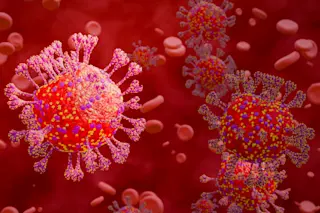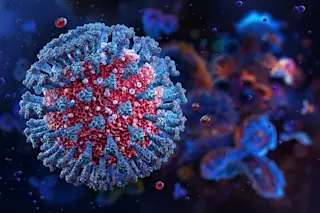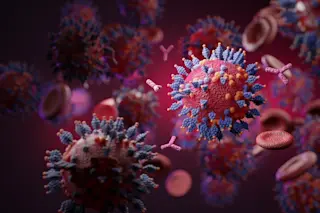It was full summer in southern Indiana. The morning mist rose through the oaks like steam. Bob Ervin was so hard at work cobbling together his daughter's playhouse in the backyard that he didn't notice anything unusual. He finished the playhouse and felt fine--for a week or so. Nine days later he woke in a sweat. Unable to return to sleep, he got up at 3 A.M. and turned on the light. The pain in his eyes was so sharp it felt like a stabbing knife. He flipped the light off and spent the rest of the night in a feverish sweat. The next day he went to the family doctor. An examination revealed a fever of 102. Except for some blood in his urine, nothing was unusual. The doctor gave him Bactrim, an antibiotic commonly used to treat urinary infections. During the next week, Mr. Ervin dutifully took the antibiotic, but the fever never broke. By the end of the week he was tired and weak; he came to the emergency room with a temperature of 103.5. The emergency room physician's examination failed to reveal any sign of infection, and the chest X-ray was clear. Routine blood cultures and chemistries were drawn and sent to me in the hospital's pathology lab. At that point, Mr. Ervin was sweating so much he was at risk of dehydration. The emergency room physician decided to admit him with the diagnosis "fever of unknown origin." Every medical student learns about this type of fever. There are several well-established strategies for figuring out the cause, but none are definitive. They can't be. There are literally thousands of causes, from a swallowed toothpick stuck in the gut to cancer to a blood clot to some strange contagion from an exotic land. The clue often lies in something overlooked in the patient's history. Just after Mr. Ervin was admitted, his family doctor visited and combed the history for a hidden cause one more time. Mr. Ervin denied a host of symptoms: coughing, vomiting, shortness of breath, pain on urination, recent weight loss. The only new details were vague complaints about discomfort after eating. His doctor then reviewed the initial laboratory results. The routine blood cultures for infections were all negative, but the blood count didn't look normal. Blood counts tell whether three types of cells--white, red, and platelets--are in correct proportion. Mr. Ervin had low levels of all three, a condition called pancytopenia. And the levels of his liver enzymes--which increase in the case of infection or early liver damage--were high. He had anemia, weakness, and fever. Trying to unite as many of the symptoms as possible in a single diagnosis, the doctor concluded that Mr. Ervin's symptoms spelled acute cholecystitis: an inflamed gallbladder. The gallbladder, roughly the size of a kiwifruit, lies just beneath the liver. Its job is to store bile produced by the liver and secrete it whenever fat needs to be digested. When the gallbladder is acutely inflamed, it's usually because stones--clumps of fatty material or bile pigment--have accumulated inside it. A patient who has a gallbladder problem will often have fever, elevated liver enzymes, and some discomfort after eating. An ultrasound of the abdomen revealed signs of gallstones. Audrey Nevins, a surgeon, was called in for a consultation. She couldn't feel the stones, but that didn't mean Mr. Ervin didn't have them. Gallstones can be difficult to detect because of their location behind the liver. Still, Nevins felt that something didn't fit the diagnosis: the pancytopenia. Problems in the gallbladder aren't associated with drops in blood count. "Have you been visiting anywhere?" she asked. "Yeah, Colorado. I was hiking last month." "Were you bitten by any animals or bugs?" "A few ticks here and there." "What do you mean Ôhere and there'?" "Some in Indiana, some in Colorado." The surgeon left the room and came to see me. In a large medical center, a case of fever of unknown origin would be handled by an infectious disease doctor, a superspecialist who knows the sexual habits of the tsetse fly and is intimate with disorders such as loa loa and looping disease. But here in rural Indiana, the doctors call me. I'm the pathologist, and I have the books. Nevins said, "Mr. Ervin went hiking in Colorado last month, and he had tick bites." "Sounds like a tick-borne disease," I said, and began paging through my family medicine textbook. Ticks transmit hundreds of diseases around the world, and in the United States they are the most common vector of infectious diseases. Several tick-borne diseases--Rocky Mountain spotted fever, babesiosis, tularemia, and Lyme--are found here, so it would be easy to narrow down the exact cause. Ticks harboring a bacterium called Rickettsia rickettsii transmit one of the most common tick-borne diseases, Rocky Mountain spotted fever. Mr. Ervin's signs and symptoms seemed to fit that diagnosis: the pancytopenia, the fever, the elevated liver enzymes, and the tick bites. "Does he have any spots?" I asked. "Not that I could see," said Nevins. I quickly scanned the description in the text and found that a small percentage of patients with Rocky Mountain spotted fever do not have spots. "How do we confirm it?" Nevins asked. I grabbed the current pathology textbook to see what I could find on diagnostic tests for the disease. She glanced into the text I was reading. "What about that one, the one in the next paragraph--chaffeensis." I skimmed the passage. Lone star ticks infected with the bacterium Ehrlichia chaffeensis, transmit ehrlichiosis, which was first diagnosed in humans in 1986. Its full name is human monocytic ehrlichiosis because the bacterium thrives inside white blood cells called monocytes. Since E. chaffeensis doesn't grow in any standard laboratory media, blood cultures for the infection turn up negative. The disease usually shows up in middle-aged men with recent tick bites, and their symptoms are typically fever, pancytopenia, elevated liver enzymes, and photophobia, or extreme light sensitivity. I had heard of ehrlichiosis, but I wasn't aware of cases in southern Indiana. "Audrey, it looks like a perfect fit," I said. "Tell him that tetracycline will probably clear it up easily." She headed out to talk with Mr. Ervin. Now it was my job to confirm the diagnosis. First I called a medical microbiologist at Indiana University. He'd never seen an ehrlichiosis case and suggested I call the Centers for Disease Control and Prevention in Atlanta. A few phone calls later, I learned of an antibody test that could identify it. The problem, though, was that it couldn't tell if the infection was current. I needed something better. I logged onto the National Library of Medicine's Web site. In a rural hospital the Internet can be a lifeline to facts. A list of 20 articles on ehrlichiosis popped up. One described a new method of testing for the pathogen's nucleic acid in the patient's blood. The author was Stephen Dumler, a medical microbiologist at Johns Hopkins. After a few phone calls, we found out what kind of blood sample to prepare, drew Mr. Ervin's blood, and sent it off to Dumler. Two days later, he called to confirm that the test had detected the presence of Ehrlichia chaffeensis.We had nailed it. Meanwhile, the surgeon had started Mr. Ervin on a week-long course of antibiotics. His temperature returned to normal. But there's an epilogue to Mr. Ervin's story. The month after we diagnosed his condition, researchers at Ball State University in Muncie, Indiana, published a study showing a high rate of ehrlichiosis among lone star ticks in southern Indiana. Some researchers believe the incidence is on the rise because of changes in the region's ecology. Oak and hickory forests are growing back, and that may be boosting the number of deer, the tick's major host. According to the Ball State study, my hometown, Jasper, Indiana, is the apparent epicenter of this infestation. With skills honed over 300 million years of evolution, the tick is a formidable foe. In the warm seasons it lies waiting for a meal of fresh blood. It alights, walks about, selects its site, unsheathes its knives (called cheliceral digits), and slashes into the victim's skin. Then it inserts its hypostome, a swordlike probe with row upon row of microscopic teeth, and begins to suck. Hours to days later, fully engorged and sometimes 100 times heavier, the tick falls off. In the meantime, there has been a small transfer of fluid from the tick to the victim. If the tick is infected with a pathogen like E. chaffeensis, it can transmit the infection in that fluid. Sometimes ehrlichiosis is so mild that cases can pass like the common flu, so it's hard to know how many cases are missed. Some researchers suspect most are. If the disease is recognized and treated with tetracycline, it's easily cured. But if it's missed and infection progresses without treatment, patients can die from causes ranging from brain infection to respiratory problems. Nearly a year has passed since Mr. Ervin encountered that tick in the woods of southern Indiana. It is now, once again, full summer here, but this time we know the beast.
The case described in Vital Signs is based on a true story. Some details have been changed to protect the patient's privacy.
Tick Talk Don't blame the messenger. Ticks are only passing along pathogens they've picked up after feeding on infected mammalian hosts--like deer or rodents. Still, they are formidably well-designed vectors: tiny (nymphal ticks are the size of a pinhead) and amazingly long-lived (some live for 15 years between blood meals). Even worse, the diagnoses of tick-borne diseases are maddening because the symptoms--fever, headache, chills, nausea--are common to many diseases. Fortunately, with the exception of Lyme disease and Rocky Mountain spotted fever, tick-borne diseases are rare. And, if they are detected early, all are easily treated with drugs. Here, in order of prevalence, are the tick-borne diseases of North America: *Lyme disease is the leading vector-borne disease in the United States. More than 10,000 cases of Lyme disease are reported each year. Lyme disease is caused by infection with the spirochete Borrelia burgdorferi. The hallmark of the disease is a bull's-eye rash at the tick bite. Carriers: Black-legged (deer) tick in the East and the Midwest; Western black-legged tick in the West. *Rocky Mountain spotted fever is caused by infection with a bacterial pathogen--Rickettsia rickettsii. More than half of all patients report a rash at the site of the tick bite. Few people die of tick-borne diseases, but when they do, it is most often because of Rocky Mountain spotted fever. Carriers: Dog ticks in the East; wood ticks in the West. *Ehrlichiosis occurs in two forms, monocytic and granulocytic. Both were identified within the past 13 years. The monocytic variety is caused by the bacterium Ehrlichia chaffeensis, which invades white blood cells called monocytes. The granulocytic variety is caused by an unnamed bacterium that thrives in white blood cells called granulocytes. Key signs of the disease are low counts of white blood cells and platelets. Carriers: Lone star tick (monocytic) and deer tick (granulocytic). *Babesiosis is caused by infection with a tick-borne parasite, Babesia microti, which infects red blood cells. Although the infection is usually curable, it can for unknown reasons be severe in people who've had their spleens removed. Carrier: Deer tick. *Tularemia is caused by infection with the bacterium Francisella tularensis. People get sick when they're bit by an infected tick or handle tissue of an infected animal, most often a cottontail rabbit. Tularemia causes distinctive skin sores and swollen lymph nodes. Interestingly, the U.S. Department of Defense considers the bacterium a possible weapon for biological warfare. Carriers: dog tick, lone star tick. *Colorado tick fever is caused by a virus that replicates in blood-forming stem cells, prompting blood count to drop. There is no specific therapy for the infection, but severe illness is rare and occurs only in children. Carrier: Wood tick. *Sporadic relapsing fever is caused by spirochetes belonging to the Borrelia family. Because the virus thrives in cave-dwelling ticks, cases tend to crop up among spelunkers. Carrier: Argasid, or soft-bodied, ticks. ------------------------------------------------------------------------ Doctor on Call "My father was an undertaker, and I grew up with autopsies being performed in my home," says pathologist Daniel Weaver. "I got to know the dead early, and I never liked them. They'd always drop by when the weather changed in October, about the time of my birthday." Weaver has taught and practiced pathology in the Midwest for 15 years. He has been a contributor to Vital Signs since 1993, and his 1995 column on endometriosis won an award from the Endometriosis Association. He and his wife, a nurse, recently relocated from Columbus, Ohio, to Jasper, Indiana, population 10,000. They are expecting their second child.













